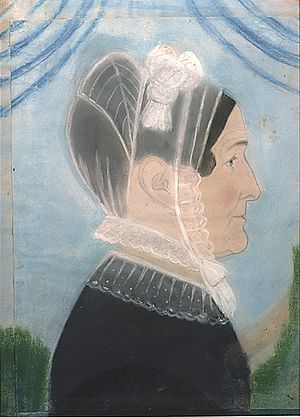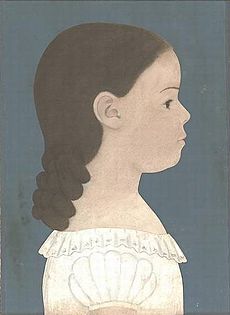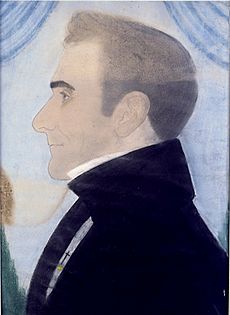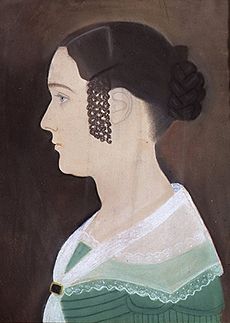Ruth Henshaw Bascom facts for kids
Ruth Henshaw Bascom (December 15, 1772 – February 16, 1848) was an American folk artist. She was also known as Aunt Ruth. She created over 1,400 portraits during her lifetime.
Ruth was born in Leicester, Massachusetts. She was the daughter of Colonel William Henshaw and Phebe Swan. Before becoming a famous artist, she worked as a schoolteacher from 1791 to 1801.
Ruth married Dr. Asa Miles when she was about 32 years old. Sadly, he passed away about a year later. She then married Reverend Ezekiel Lysander Bascom, and they were together for about 35 years. Ruth did not have her own children. However, she was a loving stepmother to her stepson and stepdaughter. She also raised her niece and nephew.
Ruth kept detailed diaries from age 17. In these diaries, she wrote about her daily life. She also recorded all the portraits she created. Besides her art, Ruth was a minister's wife and a teacher. She was also active in her local library and in groups that promoted temperance.
Ruth made her first portrait in 1801. But she started making them regularly after 1818. She used different materials for her art. These included pastels, pencils, cut paper, and even foil. Some of her early works were made by layering paper to show heads, clothes, and accessories. Later, she made pastel portraits on a single sheet of paper.
Charlotte Streifer Rubinstein, an author, described Ruth's art. She said Ruth had a "calm strength" and a "sensitive feeling for shape, color and texture."
Contents
Ruth Bascom's Early Life
Ruth Henshaw was born on December 15, 1772. Her family lived in the countryside of Leicester, Massachusetts. She was the first of ten children born to Colonel William Henshaw and Phebe Swan Henshaw. Ruth also had two older half-sisters from her father's first marriage. One of them was named Ruth, just like her.
Her father, William Henshaw, was a brave soldier. He fought in the French and Indian War. During the American Revolution, he was a key leader of the Minutemen in Worcester County. He also worked with George Washington in some battles in New Jersey.
Ruth grew up in a part of Leicester called Green Valley. We don't know much about her early schooling. Some historians think she went to local "summer term" schools for girls. These schools usually ran from April to October. She also briefly attended Leicester Academy in 1791.
Ruth kept a diary for almost every year from 1789 to 1846. These diaries are now kept at the American Antiquarian Society. In them, she wrote about her daily activities, the weather, and people who visited her. She also included details about her travels and her husband's sermons.
Ruth Bascom as an Educator
Ruth worked as a summer school teacher from 1791 to 1801. She taught children in the Leicester area. After she married Reverend Bascom, she taught up to 10 children who lived in their home. The community paid for this schooling. It was a short term that covered basic subjects, singing, and ended with a special event.
Her stepson, Clough R. Miles, lived with them and studied there in 1809. In 1814, Ruth became the superintendent of the main school in Phillipston.
Ruth also helped her community in another way. Textile mills needed "weaving cards" for their machines. Ruth taught children in her home and neighborhood how to make these cards. This small home industry helped families earn extra money.
Ruth Bascom's Family Life
In 1804, when Ruth was about 32, she married Dr. Asa Miles. He was a doctor from Westminster, Massachusetts, and had a son named Clough Rice Miles. Dr. Miles was sick for a long time and passed away in 1805 or 1806. After his death, Ruth moved back to her parents' house. She started a business making hats in Leicester.
On February 26, 1806, Ruth married Ezekiel Lysander Bascom. He was a Congregational minister in Phillipston. He had been married twice before. Ruth did not have any children of her own with Ezekiel. However, she was a very caring stepmother to his daughter, Priscilla Elvira Bascom Philbrick.
As a minister's wife, Ruth was very busy. She socialized, wrote down church events, and visited people who were sick. She was also active in temperance societies and at the library. In 1816, Ruth started recording the town's births, deaths, and marriages.
Her stepson, Clough R. Miles, lived and studied with them again when he became a teacher. His earnings helped him pay for his education at Harvard. The Bascom family also temporarily took in other children. This happened when a parent lost their spouse or when a new baby was born into a family. They also welcomed two family members into their home: Reverend Bascom's niece, Clymene Sophronia Allen, and Ruth Bascom's baby niece, Phebe Henshaw Denny.
In 1820, Reverend Bascom left his church in Phillipston. The Bascoms then moved to Ashby in 1820. Ezekiel served as a minister there for 14 years. Priscilla, Ruth's stepdaughter, became a teacher. She moved to Savannah, Georgia, in 1825, where she worked and got married. This left Phebe as the only child still living at home.
In the 1830s, the Bascoms lived in Gill, Massachusetts. Reverend Bascom's health began to get worse. He spent nine months of the year in Savannah, staying with his daughter. Ruth often visited her family and friends in New England during these winter months. When the Bascoms traveled, they often used a stagecoach.
In 1837, Ezekiel worked as a Unitarian minister in Kennebunk, Maine. After that, they moved to Fitzwilliam, New Hampshire. Reverend Bascom passed away on April 2, 1841. After his death, Ruth traveled around Massachusetts and Maine. She lived in a boarding house in Ashby.
Ruth Bascom: The Artist
Ruth Bascom's Portrait Work
Ruth Bascom created portraits of her friends and family. She made these when she lived with her husband in Ashby. She drew life-size head-and-shoulder profiles using pastels on paper. She continued making portraits even after her husband died.
In her diaries, Ruth mentioned making over 1,400 portraits. Today, about 185 to 215 of these are still known to exist. Ruth loved children, and about one-third of her portraits were of them. Most of her pastel crayon portraits were made in the 1830s when she lived in Gill, Massachusetts.
Ruth Bascom and Susanna Paine were two of the few women who worked as traveling portrait artists in the late 1700s and early 1800s.
Sometimes, Ruth did not get paid for her portraits. This happened if they were gifts or if people could not afford to pay. Other times, she accepted goods instead of money. Or she received $1 to $3, depending on the frame's quality. For example, when she made a portrait of Fanny Goodnow Parmenter in 1829, she received $2.25. This money was used to pay for the glass and the picture frame.
How Ruth Bascom Created Her Art
Ruth started making portraits in 1801. She would trace the shadow of a person's profile. She did this by placing drawing paper on a wall in a dark room. A lamp or candlelight would cast the shadow. At that time, cutting out profiles was a popular game and an inexpensive way to make art.
She didn't make many portraits in the early 1800s. She only recorded making seven between 1801 and 1808. She didn't mention profiles again until 1818. Then, she started making profiles in the evenings. She would draw the person's features and other details with a pencil.
Ruth used two main ways to create her portraits. Until the mid-1820s, she would cut out shapes on the portrait paper. A dark background would show through these cuts to form features. In 1828, she began making collages. She would cut out clothing from paper. She used metal foil for buttons, jewelry, and eyeglasses. These pieces were layered onto the cut-out of the person's head and neck. For example, her portrait of Elizabeth Cummings Low (1829) is a collage. It has crisp lines that remind you of shadow tracing. Sometimes, she even used silk ribbons in her artwork.
In the mid-1830s, she started drawing portraits on a single sheet of paper. The background might be brown or blue pastel. It could include dark green trees or ruffled curtains. Sometimes, she added arcs in the upper corners to make it look like an oval frame. She continued to make collage-style portraits for a while too.
Ruth Bascom's Death
Ruth Bascom passed away on February 15, 1848, in Ashby, Massachusetts. Most of her portraits, especially those from the 1830s, were found in Franklin County, Massachusetts.
Collections of Ruth Bascom's Art
You can find Ruth Bascom's artwork in many museums and collections, including:
- American Folk Art Museum, New York City
- American Museum in Britain, Claverton Manor, Bath, England
- Daughters of the American Revolution Museum, Washington D.C.
- Deerfield Academy, Massachusetts
- Fenimore Art Museum, Cooperstown, New York
- Fitzwilliam Historical Society, New Hampshire
- Five Colleges and Historic Deerfield Museum Consortium
- Leicester Library, Massachusetts
- Museum of Fine Arts, Boston
- Old Sturbridge Village, Massachusetts
- Philadelphia Museum of Art, Pennsylvania
- Winterthur Museum, Garden and Library, Delaware
- Worcester Art Museum, Massachusetts
Some of Ruth Bascom's Works
Here is a list of some of Ruth Bascom's known artworks:
- Woman on Blue Background, pastel, c. 1800
- Fanny Goodnow Parmenter, pastel and pencil on paper, 1829
- Eliza Ann Hubbbard (1826–1901), pastel and pencil on paper, 1830
- Ellen Jane Hubbard, 1830
- Ezekiel Lysander Bascom (1777–1841), pastel on paper, c. 1830
- George B. Hubbard, 1830
- Jonathan A. Hubbard, 1830
- Self-portrait, pastel on paper, c. 1830
- Thomas Cushing Barr (1823–1872), pastel and pencil on paper, 1834
- Cutout Profile of a Lady, c. 1835
- Eliza Jane Fay, 1840
- Self-portrait, pastel on paper, c. 1840
- Three Pastel Heads, unknown date
- Miss Nancy Rawson (c. 1757-1848), watercolor drawing, unknown date





